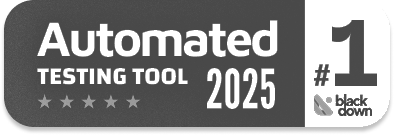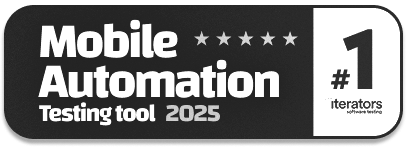Full-Stack Tester: Role and Skills
|
|
The software industry is currently more aggressive and is no longer interested in seeking resources that concentrate only on one field of development or testing. They need people who can work on the end-to-end development of software applications or those who can work on testing the entire application.
The role of a Full-Stack Tester has become essential as organizations adopt continuous integration, continuous deployment (CI/CD), and DevOps practices. A full-stack tester differs from other testing roles, which are typically limited to only front-end or back-end testing. A full-stack tester is a person responsible for testing an application’s UI, API, database, security, and performance, among other things.
Who is a Full-Stack Tester?
A full-stack tester is a Quality Assurance (QA) specialist that conducts testing on all layers of a software application, which are:
- Front-End (UI) Testing: Make sure the user interface works and is responsive and accessible.
- Back-End (API) Testing: Validates the correctness, security, and performance of APIs and microservices.
- Database Testing: Verifying data integrity, schema validation, and query performance.
- Security Testing: Detects loopholes like SQL injection, cross-site scripting (XSS), and authentication vulnerabilities.
- Performance Testing: Verifies the system can perform under various load levels without losing quality.
- DevOps & CI/CD Integration: This integration adds automated tests to CI/CD pipelines, allowing software to be released more quickly.
Similar to a Full-Stack Developer, a Full-Stack Tester focuses on testing the entire application rather than building it.
Roles of a Full-Stack Tester
A full-stack tester works across multiple layers of an application, covering different testing types:
Frontend Testing (Client-Side)
- Ensure UI/UX designs are responsive, accessible, and user-friendly across different screen sizes and devices.
- Validate the functionality of UI elements like buttons, forms, and navigation to ensure proper user interaction.
- Conduct cross-browser testing on Chrome, Firefox, Safari, and Edge to verify compatibility and consistent behavior.
- Perform cross-device testing on desktops, mobile phones, and tablets to ensure seamless user experience across platforms.
- Analyze client-side performance by measuring loading speed, rendering efficiency, and caching effectiveness to optimize UI responsiveness.
Read more about UI testing: UI Testing: What You Need to Know to Get Started.
API Testing
- Verify RESTful and GraphQL APIs for accuracy, performance, and security to ensure reliable data exchange between services.
- Validate API responses, HTTP status codes, headers, and payloads to confirm proper communication and error handling.
- Automate API testing using tools like Postman, SoapUI, and RestAssured to improve efficiency and coverage.
- Conduct contract testing with Pact to ensure API compatibility and prevent breaking changes between services.
Read more about UI testing: API Contract Testing: A Step-by-Step Guide to Automation.
Database Testing
- Ensure data integrity, consistency, and accuracy in both relational (SQL) and NoSQL databases to maintain reliable storage and retrieval.
- Validate CRUD (Create, Read, Update, Delete) operations to confirm correct data manipulation and persistence.
- Use SQL queries to verify database interactions and ensure seamless communication between the application and the database.
- Automate database testing with tools like DBUnit or Flyway to streamline validation and detect schema inconsistencies.
Understand the Database Testing Best Practices.
Security Testing
- Identify security vulnerabilities such as SQL injection, Cross-Site Scripting (XSS), and Cross-Site Request Forgery (CSRF) to prevent potential threats.
- Validate authentication and authorization mechanisms to ensure secure user access and data protection.
- Use OWASP ZAP and Burp Suite to detect security flaws and analyze potential attack vectors.
- Conduct penetration testing to uncover security loopholes and strengthen application defenses.
- Ensure the application complies with security best practices and industry standards like OWASP, GDPR, and HIPAA.
More about Security Testing here.
Performance Testing
- Evaluate the application’s response time, scalability, and load-handling capacity to ensure optimal performance.
- Verify that the system can sustain peak user loads without crashes or slowdowns.
- Use performance testing tools like JMeter, Gatling, and k6 to benchmark system efficiency.
- Identify performance bottlenecks and recommend optimizations to improve system responsiveness.
- Ensure system stability under heavy concurrent user activity by simulating real-world traffic conditions.
Understand What is Performance Testing: Types and Examples.
DevOps and CI/CD Integration
- Integrate automated tests into Continuous Integration/Continuous Deployment (CI/CD) pipelines to enable faster and more reliable software releases.
- Ensure smooth execution of automated tests in containerized environments like Docker and Kubernetes.
- Use CI/CD tools such as Jenkins, GitHub Actions, and GitLab CI to automate test execution and deployment validation.
- Implement shift-left testing to identify defects early in the development cycle, reducing the cost of fixing issues.
- Collaborate with developers and DevOps teams to optimize test automation strategies and improve overall software quality.
End-to-End Testing
- Simulate real-world user interactions across various layers of the application to validate end-to-end functionality.
- Ensure seamless workflow execution by testing complete user journeys from start to finish.
- Use tools like testRigor to automate end-to-end (E2E) testing and improve test efficiency.
- Detect integration issues between system components to prevent failures in interconnected services.
- Ensure a smooth user experience across web, mobile, and API interactions by validating system behavior under different scenarios.
Key Responsibilities of a Full Stack QA
A full-stack tester is responsible for ensuring end-to-end quality across different layers of the application:
Test Planning & Strategy
Full-stack tester work with developers, product managers, and DevOps teams to create test strategies that are driven by company objectives. They write test plans, create test cases and automation scripts, and prioritize test cases based on risk assessment to provide maximum coverage and efficiency.
Test Execution
The full-stack tester performs both manual and automated testing on the entire technology stack (UI, API, database) to ensure all parts of the application work seamlessly together. They use tools like JIRA, Azure DevOps, or Bugzilla to identify, document, and track defects and perform thorough regression testing after every release. Also, they verify that integration points between frontend, backend, and third-party services maintain consistency of data and communication within the system.
Test Automation
To manage the time efficiently and effectively, full-stack testers identify automation tools that help them focus their efforts more on improving the test coverage rather than maintaining the automation scripts. That’s why full-stack testers prefer testRigor. It is a one-stop testing tool that supports different types of testing like web, mobile apps, desktop apps, APIs, visual testing, and accessibility testing. Also, with its built-in integrations for CI/CD tools like Jenkins and CircleCI, test management systems like TestRail, defect trackers like Jira, and communication tools like Slack and Microsoft Teams, testRigor helps to reduce the task overburden of a full-stack tester.
Performance & Load Testing
The full-stack testers execute load, stress, and endurance tests to track system bottlenecks and scalability issues. They evaluate system stability and responsiveness under various workloads, making sure that the application can accommodate peak user load without degradation or failures.
Security & Compliance Testing
They conduct security testing to detect vulnerabilities, such as those listed in the OWASP Top 10, ensuring robust protection against cyber threats. They validate authentication mechanisms, encryption standards, and data privacy compliance while ensuring the application adheres to security regulations like GDPR, HIPAA, and ISO.
Continuous Testing & Monitoring
With a shift-left approach where testing is integrated into the DevOps pipeline, full-stack testers make sure the early detection of defects and continuous quality improvement. They monitor logs, errors, and system health using tools like New Relic, Splunk, and ELK while using AI-based testing tools like testRigor for intelligent, automated end-to-end testing. This reduces maintenance efforts and enhances test accuracy.
Comparison: Full Stack Testing vs. Traditional Testing
The need for a full-stack tester as a role has arisen because modern software engineering processes require testing across the entire application stack—front-end UI, back-end APIs, databases, security, and performance. Traditional testers, on the other hand, usually specialize in one layer of testing (e.g., Manual testing, UI testing, API testing, etc.).
| Aspect | Traditional Tester | Full Stack Tester |
|---|---|---|
| Scope | Focuses on either UI, API, or database testing | Tests UI, API, database, performance, security, and DevOps integration |
| Automation | May focus on either manual or automation testing | Proficient in automation across all application layers, as well as in manual testing |
| Performance Testing | Not always involved | Actively tests system scalability and load handling |
| Security Awareness | Limited exposure | Deep understanding of security vulnerabilities |
| CI/CD Integration | May not work with DevOps | Integrates testing within CI/CD pipelines |
| End-to-End Testing | Limited scope | Covers full application workflows |
Career Path for Full Stack Testers
The career of full-stack testers is diverse and presents plenty of room for advancement within QA, automation, DevOps, and software development. They can pivot towards specialized roles in UI, API, database, performance, security, and CI/CD testing or towards leadership roles based on their skills and interests. Below is a career graph of full-stack testers.
- Entry-Level QA Engineer: Begins with basic testing roles, focusing on manual testing, test case execution, and defect tracking. Read: Top AI QA Tester Job Interview Questions.
- Automation Engineer / SDET: Develops expertise in test automation frameworks, API automation, and CI/CD integration. Read: SDET Interview Questions and Top-30 QA Automation Engineer Interview Questions (+Answers).
- Senior Full Stack Tester / QA Lead: Leads testing efforts across UI, API, performance, and security testing, mentoring junior testers.
- QA Architect / Test Automation Architect: Designs test automation frameworks, selects tools, and optimizes CI/CD processes.
- DevOps Engineer / Security Tester: Specializes in continuous testing, cloud-based testing, or penetration testing.
- QA Manager / Director of QA: Oversees testing teams, defines quality metrics, and aligns test automation strategies with business goals. Read How to Become a QA Manager? and Top 24 QA Manager Interview Questions (+Approaches & Answers).
Conclusion
Modern software development has made the role of Full Stack Tester an important one, with expertise involving testing at various levels such as UI, API, database, security, performance, and automation testing. To maintain software quality at all stages, a Full Stack Tester must be on a continuous journey of adapting, learning, and integrating testing practices.
By mastering tools, techniques, and best practices, Full Stack Testers can contribute significantly to delivering robust and high-quality software.
| Achieve More Than 90% Test Automation | |
| Step by Step Walkthroughs and Help | |
| 14 Day Free Trial, Cancel Anytime |












